Dear Zazie, Here is today’s Lovers’ Chronicle from Mac Tag dedicated to his muse. What favorite reveries do you return to again and again? Rhett
The Lovers’ Chronicle
Dear Muse,
© copyright 2020 mac tag/cowboy coleridge all rights reserved
© copyright 2019 mac tag/cowboy coleridge
some barely touch it
but it sure touches them
beautiful, my friend
every day i discover
even more
it is intoxicatin’
i want to paint it all,
write it all
burstin’ with ideas
i start to see and understand
it seems as if i can see
us
this is what we should be
workin’ on, continuously…
return and return again, where one ends
another begins; who is dreamin’ who
if one is ardent, the eyes will see
all that can be stretchin’ out
however, different, you like this
the opposite of love’s indifference
at first, and as sacred, we touch
two made whole, a touch
and tenderness did the rest
it means that we can dance,
that we can finally stop searchin’
none too soon in us, we found
for our journey, bodies of mortals
and souls paid for in weights of old
© copyright 2017 mac tag/cowboy Coleridge all rights reserved
Today a poem, on our favorite topic, and a song, for you. The Poem of the Day was inspired by readin’ some classic Italian literature. It really is random and bounces around so I hope you can follow my randomness and I hope you like it.
Random Reveries
| Return and return again, where one ends |
| Another begins; who is dreamin’ who |
| The beauty and Her dark shadows |
| If one is ardent, the eyes will see, |
| Loveliness stretched out sensuously |
| However, different, you like this |
| It seems that this must be Limbo |
| At first, and as sacred, we touch, |
| In rhyme and rhythm and rhapsody |
| That would go to infinity, |
| And also in passionate madness |
| But I say, well, she made me whole |
| Her touch and tenderness did the rest, |
| That hot-blooded flesh an invitation |
| It means that you can dance again, |
| It is necessary for la bella vita, |
| And faith, and removin’ doubt |
| Not so soon in me, she looked, |
| That adage is one can hardly see, |
| She left rather than renounce love |
| When the cold wind blows, |
| You do not always write the right words |
| Time vows Her vengeance |
| To be blunt, bold and liberal |
| Over the course of many nights |
| So then let loose those two sinners |
| Me, and Mal, that Time gave us, |
| For our journey, bodies of mortals |
| And souls paid for in weights of old |
| Because a heart that has little standin’, |
| Will die soon, if not tenderly treasured |
| Oh lucky you, that truth and Time, |
| With scythe and scales in Her hand, |
| Sends you back out of the vastness |
| Beautiful face and fervent feelin’s |
| That thirst only the adventurous |
| These reveries swirl in and out, |
| The mortal enemies of madness
Thus it is to constantly seek sanity, As the totem continues to spin |
© copyright 2012 mac tag/Cowboy Coleridge all rights reserved
The Song of the Day is “Rêverie” by Claude Debussy.
| Claude Monet | |
|---|---|

photo by Nadar, 1899.
|
|
Today is the birthday of Oscar-Claude Monet (Paris; 14 November 1840 – 5 December 1926 Giverny); founder of French Impressionist painting, and the most consistent and prolific practitioner of the movement’s philosophy of expressing one’s perceptions before nature, especially as applied to plein-air landscape painting. The term “Impressionism” is derived from the title of his painting Impression, soleil levant (Impression, Sunrise), which was exhibited in 1874 in the first of the independent exhibitions mounted by Monet and his associates as an alternative to the Salon de Paris. Monet’s ambition of documenting the French countryside led him to adopt a method of painting the same scene many times in order to capture the changing of light and the passing of the seasons. From 1883 Monet lived in Giverny, where he purchased a house and property, and began a vast landscaping project which included lily ponds that would become the subjects of his best-known works. In 1899 he began painting the water lilies, first in vertical views with a Japanese bridge as a central feature, and later in the series of large-scale paintings that was to occupy him continuously for the next 20 years of his life.
In January 1865 Monet painted Camille or The Woman in the Green Dress (La femme à la robe verte), one of many works using his future wife, Camille Doncieux, as his model. The following year Monet used Camille for his model in Women in the Garden, and On the Bank of the Seine, Bennecourt in 1868. Camille became pregnant 1867. Monet and Camille married on 28 June 1870, just before the outbreak of the Franco-Prussian War, and, after their excursion to London and Zaandam, they moved to Argenteuil, in December 1871. He and Camille lived in poverty for most of this period.
In 1876, Camille became ill with tuberculosis. In the summer of that year, the family moved to the village of Vétheuil where they shared a house with the family of Ernest Hoschedé, a wealthy department store owner and patron of the arts. In 1878, Camille Monet was diagnosed with uterine cancer, and she died on 5 September 1879 at the age of thirty-two.
Monet made a study in oils of his dead wife. Many years later, Monet confessed to his friend Georges Clemenceau that his need to analyse colours was both the joy and torment of his life.
While Monet continued to live in the house in Vétheuil, Alice Hoschedé helped Monet to raise his two sons, Jean and Michel. She took them to Paris to live alongside her own six children. In the spring of 1880, Alice Hoschedé and all the children left Paris and rejoined Monet at Vétheuil. In 1881, all of them moved to Poissy. In April 1883, looking out the window of the little train between Vernon and Gasny, he discovered Giverny in Normandy. Monet, Alice Hoschedé and the children moved to Vernon, then to the house in Giverny. Following the death of her estranged husband, Monet married Alice Hoschedé in 1892.
Monet died of lung cancer at the age of 86 and is buried in the Giverny church cemetery. Monet had insisted that the occasion be simple; thus only about fifty people attended the ceremony.
His home, garden, and waterlily pond were bequeathed by his son Michel, his only heir, to the French Academy of Fine Arts (part of the Institut de France) in 1966. Through the Fondation Claude Monet, the house and gardens were opened for visits in 1980, following restoration. In addition to souvenirs of Monet and other objects of his life, the house contains his collection of Japanese woodcut prints. The house and garden, along with the Museum of Impressionism, are major attractions in Giverny, which hosts tourists from all over the world.
Gallery



par Carolus-Duran, 1867
Musée Marmottan Monet, Paris
-
La Femme en robe verte, 1866.
-

Femmes au jardin, 1866.
-

Bain à la Grenouillère, 1869.
-

Portrait de son fils Jean en bonnet à pompon , 1869
-

La route de Versailles à Louveciennes, effet de neige, 1870.
-

Le Port de Trouville, 1870.
Londres et les Pays-Bas (1870-1871)
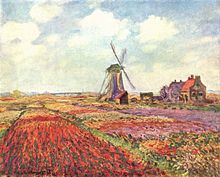
Argenteuil (1871-1877)

-

Jean Monet sur son cheval à bascule, 1872.
-
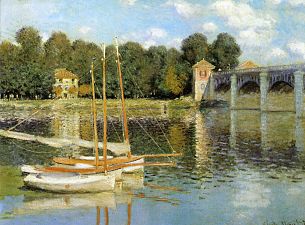
Le Pont d’Argenteuil, 1874.
-
La Promenade, 1875.
-

Camille sur son lit de mort, 1879.
-
Michel Monet au pompon, 1880.
Retour à Paris puis Vétheuil (1878-1880)


Installation à Giverny et voyages en série (1883-1889)
-

Mer agitée à Étretat, 1883.
-

Le Manneporte à Étretat, 1886.
-

Étretat sous la pluie, 1886.
-
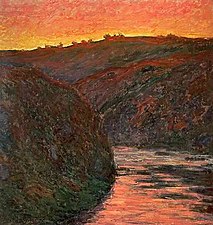
Creuse, soleil couchant, 1889.
Le temps des séries
Les Meules (1890-1891)
-

Meules, milieu du jour.
-
Meules, soleil couchant.
-
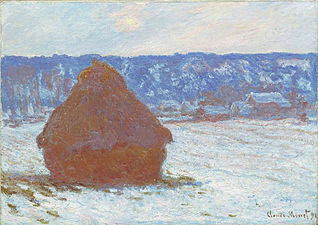
Meules, effet de neige, temps couvert.
-
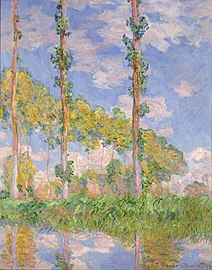
Les peupliers, sous le soleil
-
Les peupliers, dans le vent.
-
Les Peupliers, trois arbres roses, automne.
Les Cathédrales de Rouen (1892-1895)
Les Matinées et le début des Nymphéas
-
Bras de Seine près de Giverny (1897)
-

Matinée sur la Seine (1897)
-

Le Bassin aux Nymphéas, harmonie verte (1898)
-

Nymphéas (1897-1898)
-

Nymphéas (1897-1899)
Voyages à Londres (1899-1904)
-

Le Parlement, coucher de soleil.
-

Le Parlement, reflets sur la Tamise.
-

Le Parlement, soleil couchant.
-

Charing Cross Bridge.
-

Waterloo Bridge.
Les Nymphéas
-

Nymphéas, 1904.
-

Nymphéas, 1904
-

Nymphéas, 1906.
-
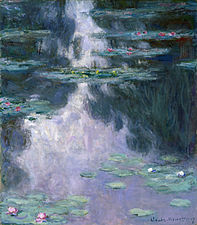
Nymphéas, 1907.
Venise
-

Palazzo da Mula.
-

Le Palais ducal.
-
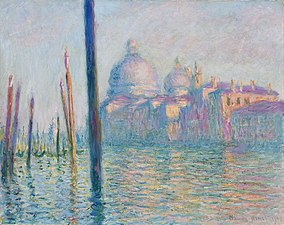
Le Grand Canal.
-

Saint-Georges Majeur au crépuscule.
Cataracte et grandes décorations
-
Grande décoration, entre 1914 et 1926.
-
-
-
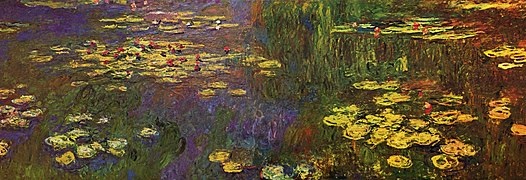
-

Claude Monet dans son jardin vers 1917, autochrome de Clémentel
-

-

-




Japonaises

-
 Pruniers en fleur (1879).
Pruniers en fleur (1879).
-

Trois bateaux de pêche (1886).
-
 Nature morte aux œufs (1907).
Nature morte aux œufs (1907).
Marché de l’art

-

Bazille, L’Ambulance improvisée, 1865.
-

Monet lisant, par Renoir, 1872.
-

Monet peignant dans son jardin en 1873 par Renoir
-
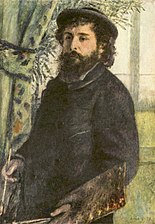
Pierre-Auguste Renoir, Portrait de Monet, 1875.
-

Claude Monet peignant dans son atelier de Manet en 1874.
-

John Singer Sargent, Monet peignant à l’orée d’un bois, 1885.
Cinéma
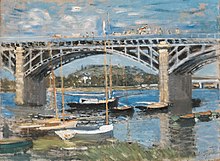
Mac Tag
Follow us on twitter @cowboycoleridge



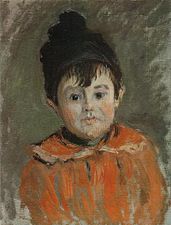
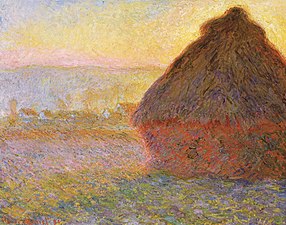





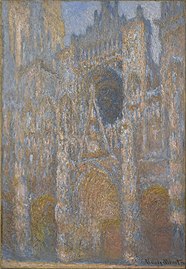


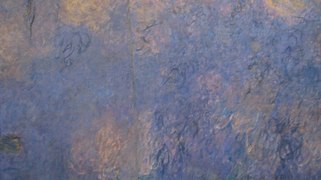
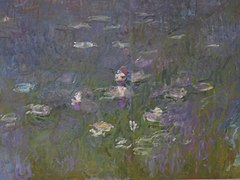
No Comments on "The Lovers’ Chronicle 14 November – two – random reveries – art by Claude Monet"